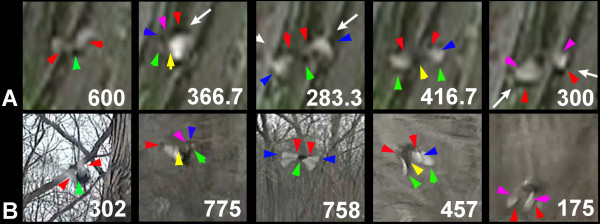Figure 2.

A copy of Figure 1 with plumage similarities between comparable frames highlighted. (A frame 600 and B 302): green arrowhead, black body with white of opposite wings apparently almost meeting; red arrowheads, apparent white trailing edge to wings. (A frame 366.7 and B 775): note these images are in reverse orientation with respect to each other because the bird in A is flying away to the right, whereas that in B is flying away to the left. Yellow arrowheads, inconspicuous trace of black trailing edge to underwing; Red arrowheads, apparent black wingtips; green arrowhead, apparent white trailing edge to upperwing; blue arrowhead, black upperwing with apparent white leading edge (purple arrowhead). (A frame 283.3 and B 758): blue arrowheads, black wingtips on apparently largely white wings; red arrowheads, apparent black leading edge to upperwings; green arrowheads, narrow, apparently all black body. (A frame 416.7 and B 457): yellow arrowheads, all black body (no white); green arrowheads, apparent black wingtips, in fact black trailing edges; red arrowheads, apparent black leading edges to wings; blue arrowheads, apparent smudges on white surface of wing. (A frame 300 and B 175): red arrowheads, apparent black wingtips. In the upper panel (the putative Ivory-billed Woodpecker), although partly obscured by a tree branch the black appears to wrap around a large panel of white in the wing (see also frame 416.7). This is difficult to reconcile with the plumage of Ivory-billed Woodpecker, except as an artifact of rapid motion, but in the lower panels is clearly identifiable as consistent with the black wingtips and trailing edge surrounding the white panel on the underwing of Pileated Woodpecker. Purple arrowheads, largely white underwing white wing surface with dusky markings, a pattern which can be characteristic of Pileated Woodpecker due to the fact that the inner wing is not translucent because of the backing of bone and other thick tissues. The white arrows were superimposed on the original figures in Fitzpatrick et al [1]. Reproduced from [1] with permission from David Luneau.
